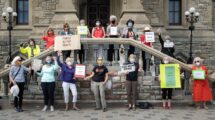 Healthy Boomer
Healthy Boomer
Peggy Edwards
Understanding the contributions of older people
The other day, I saw another alarming report in the media about how our aging population is a burden to the next generation. Indeed, we will bankrupt our healthcare system and drain the Canada Pension Plan dry.
I spoke with Lillian Zimmerman, age 95, about the question of whether or not our growing population of older people represents a burden or a benefit to society. Lillian is an author and long-time adult educator and researcher at the Simon Fraser University Gerontology Research Centre. At age 92, she published a lively book called Did You Just Call Me Old Lady? which debunks the prevailing myth that older people are a burden and fail to make significant contributions to society.
Lillian said, “I deplore the ‘population aging as a crisis’ story that is so often found in the media, portraying those of us who are old as a threat and burden. This is both untrue and harmful. Such thinking robs people of self-respect and constitutes a failure to recognize what older people have achieved. We have accomplished a great deal of good and will continue to do so.”
Some of the best research shows that, although health care costs will rise as baby-boomers age, the impact will be modest in comparison to that of other cost drivers, such as inflation and technological innovation. The Canadian Institute for Health Information has shown that population aging is a stable, modest driver of increasing health care costs, estimated at less than one per cent per year. This is a far cry from alarmists who believe increased population aging will threaten our valued pension and medical systems.
Contrary to the prevailing myth, older persons are a benefit, not a burden to society. They make important contributions to their families, communities and country, not just economically but also in other significant ways.
How do seniors contribute to society?
Like younger people, seniors spend money shopping, using services (which employ people) and paying taxes. Many help out their adult children and grandchildren with expenses related to housing, childcare, lessons, camps and sport and recreation activities. They give generously to charitable organizations. In fact, seniors make more donations per capita than any other age group.
Older people work, both in paid and unpaid jobs. Increasingly, older Canadians are remaining in the paid workforce after age 60. The labour force participation rate for those aged 60 years and over nearly doubled from 14 per cent in 1997 to 26 per cent in 2017. Many seniors see work as a fulfilling pastime. Increasingly, however, working longer is a financial necessity for older Canadians. This is especially true for women and immigrants that have lower incomes due to less years of employment and higher rates of employment in sectors that do not provide benefits or pensions.
Older people work outside of formal employment in a number of important ways
Older Canadians volunteer in large numbers, with about 41 per cent of Canadians aged 55 to 64 and 36 per cent of Canadians 65 and older giving their time to community and social activities, groups and causes. Given the breadth of life and work experiences they have had, these older adults are well-suited for the leadership, administrative, programmatic and operational roles they assume.
While it is true that older people are the most common recipients of informal care, such as helping with daily tasks (cleaning, cooking, etc.), transportation and personal care, it is important to recognize that seniors are also caregivers. Many older people reach out to help neighbours, friends and family members who have health problems. They do home visits, deliver meals on wheels and provide companionship to others who would be socially isolated without the helping hand and quick smile that older friends and neighbours offer. Among my friends (who are mostly in their 70s), some are helping to care for older parents, some take friends to medical appointments, some help older people with disabilities to shop, garden and cook, and some are taking part in a network of friends who have come together to stay with a dying friend or family member. Most support their adult children in their parenting role and spend as much time as possible with grandchildren.
Older women look after their spouses when they become frail or ill. An older man who lives up the street looks after his wife who has developed dementia, making sure that she is dressed, well-fed and safe in as normal an environment as possible. This unpaid, informal caregiving by both older women and men. allows their loved ones to stay in the community and delays moving to long-term care, which is expensive for the system and the family.
And then there is childcare. It is not known how many hours grandparents spend looking after grandchildren and taking them to activities. We do know they are an important cornerstone in their families for all types of support — practical, social, and financial. Many babysit, provide care after-school or on days off school, allowing parents to breathe easy at work and not have to pay for formal, high-cost childcare. Grandparents serve many roles: they are mentors, cheerleaders, caregivers, teachers, historians and confidants. They often pay for activities (such as swimming lessons) and take them to outings. Grandparents who live with grandchildren make a substantial financial commitment to running the household and sometimes serve as the primary caregiver, so that parents can work outside the home.
It is hard to put a price tag on the value of these contributions. Analysts estimate that in 2010, volunteers over the age of 65 contributed a total of 372 million hours with a value of $5.5 billion dollars. The economic value of informal caregiving is astounding. It is estimated that caregivers who look after seniors save Canada’s health care system between $24 to 31 billion annually.
But more important than money is the incalculable benefits that older people provide to individuals, families and communities, many of whom are vulnerable and in need of help and love.
Increasingly, older Canadians are also involved in social justice and political work, often in partnership with younger generations. Many grandmothers marched in solidarity with thousands of young people at the September 27 climate strike protest march. “It was an honour to march with all of those committed young people,” said my friend and co-author Mary Jane Sterne. “They will drive the changes we need for a better future for the next generation and for our planet.”
Back to Lillian who wrote in a recent correspondence, “There are vast gaps in the failure to recognize how older people in Canada are benefactors contrasted to outdated, regressive views that they are dependent and burdensome. It is imperative that such gaps be eliminated because they are ageist, and barriers to our understanding of the contributions older people make. How do we respond to the projection that the population of those over eighty years could reach over 63.5 million over the next fifty years? You might gasp with surprise and start worrying about how we can handle such numbers. My response — as a long-time researcher in gerontology and a woman in her 90s who sees the contributions of older people, I say — bring it on!”
Peggy Edwards is a well-known writer and speaker on aging and health and is a co-author of The Healthy Boomer: A No Nonsense Midlife Health Guide for Women and Men, The Juggling Act: The Healthy Boomer’s Guide to Achieving Balance in Midlife, and Intentional Grandparenting: A Boomer’s Guide, all available at amazon.ca. Did You Just Call Me Old Lady? by Lillian Zimmerman is also available at amazon.ca






